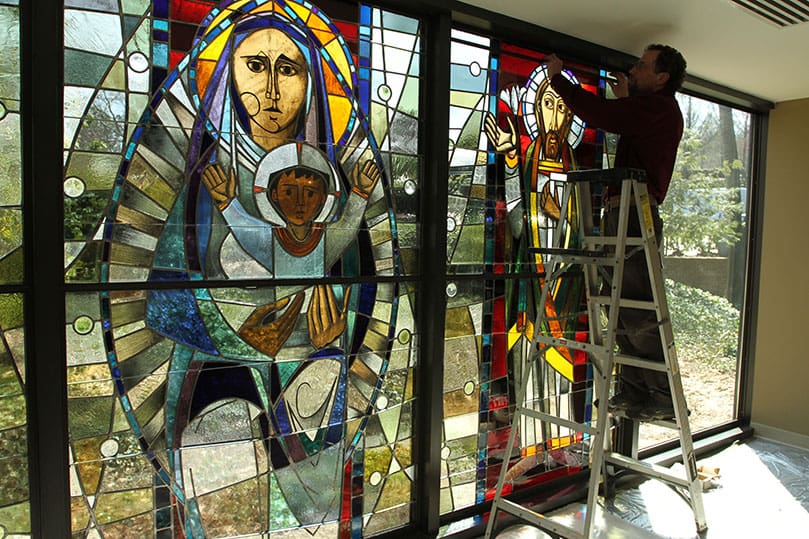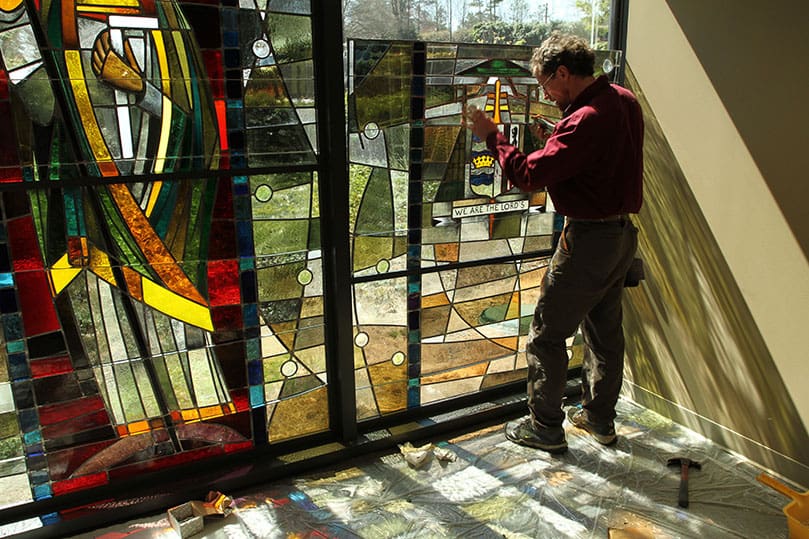David Frei prepares to install the steel reinforcing bar to the Coat of Arms window. Photo By Michael Alexander
Smyrna
Windows Transform Room Into St. Dominic Chapel
By ANDREW NELSON, Staff Writer | Published May 12, 2011
The large ground floor room could serve as a nice conference room, with its picture windows looking out on trees, shrubs and greenery.
But instead, David Frei transforms the room with the makings of a chapel as he installs five stained glass windows.
It is his favorite part of the job, he says. Manufacturing windows takes many months to complete and craftsmen only see small sections of the project at a time, but at the installation, all the work comes together finally, he says.
“You get to see the totality, which is very pleasing,” he says.
The 65-seat chapel is in the Atlanta Archdiocese’s new Catholic Center on Lake Park Drive in Smyrna. Archbishop Wilton D. Gregory selected as the chapel namesake St. Dominic, his confirmation patron saint. On Thursday, May 26, the chapel of St. Dominic will be blessed and begin to be used for weekday Mass for the staff and first Friday adoration of the Blessed Sacrament.
David is the fourth generation to work in the family business designing church windows.
According to company history, Bavarian-born Emil Frei Sr. studied at the Munich Academy of Art and immigrated to New York to escape the military service then required in Germany. There he was joined by his fiancée, Emma Mueller of Heidelberg, whom he soon married. After a trip to California, the couple ended up in St. Louis and in 1900 he opened his own studio. He specialized in what’s called “Munich style windows,” which are known for being very colorful, precisely drawn figures and lush landscapes. Craftsmen worked on large glass panels, different from the older, medieval window style of smaller pieces of colored glass held in a leaded framework. Frei’s work can be seen in Atlanta’s Sacred Heart Basilica.

David Frei of the Emil Frei Stained Glass Company, St. Louis, Mo., uses a silicone sealant to caulk the windows. Photo By Michael Alexander
David jokingly says his great-grandfather is still finding work for the company. The studio works on all aspects of church windows, from design to restoration efforts, and it isn’t uncommon for the current generation to spend time reconditioning windows created nearly 100 years ago by their great-grandfather and grandfather, he says.
David’s equipment fills about half the empty room. On one end is the metal cutting equipment that creates a piercing sound as it cuts the metal frames. A hand tool causes sparks as David finishes the finer work trimming the metal.
On the other side of the room, the five windows are in pieces. They lean against a wall. The saints—Mary and the Christ Child, St. Dominic and St. Joseph—are in two parts and when installed will measure more than eight feet high and a yard wide. The windows for the crest of the archdiocese and the coat of arms for Archbishop Gregory are in three pieces. A sketch of the final design rests on the floor to guide the work.
He doesn’t rush. He measures, measures again, cuts, fixes a frame into place and fiddles with the piece to ensure it’s right.
Frei uses a silicone sealant to caulk the windows.
Church window styles over the generations have moved away from the company’s early work. In contrast to the Munich style windows, the three windows in this chapel are more sculptural than painting.
He explains the windows use the glass so it doesn’t look just like lit painting. He says modern glassblowing makes the glass pieces have very different appearances; some are dark, others are transparent, others are more colorful. At its best, when the pieces are put together the glass shards create the look of three-dimensional sculpture more than painting, David says.
The look of the windows is always changing, he says, adding how at one point in the day he saw how sun reflects off cars windows in the nearby parking lot and makes the windows glow.


